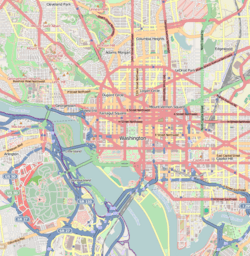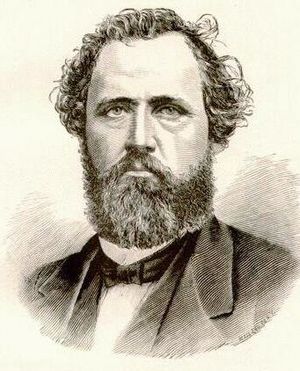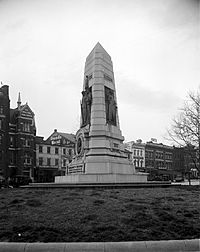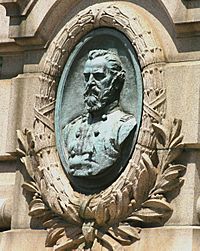Stephenson Grand Army of the Republic Memorial facts for kids
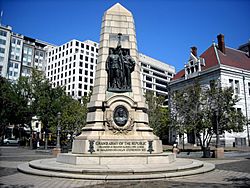 |
|
| Location | Indiana Plaza, Washington, D.C., United States |
|---|---|
| Designer | J. Massey Rhind (sculptor) Rankin, Kellogg & Crane (architects) Roman Bronze Works (founder) William Gray & Sons, P. R. Pullman and Company (contractors) |
| Material | bronze (sculpture) granite (shaft) concrete (base) |
| Height | 25 feet (7.6 m) (shaft) 2 feet (0.61 m) (base) |
| Opening date | July 3, 1909 |
| Dedicated to | Benjamin F. Stephenson |
|
Stephenson Grand Army of the Republic Memorial
|
|
|
U.S. Historic district
Contributing property |
|
| Part of | Civil War Monuments in Washington, D.C. |
| NRHP reference No. | 78000257 |
| Added to NRHP | September 20, 1978 |
The Stephenson Grand Army of the Republic Memorial is a public artwork in Washington, D.C.. It honors Dr. Benjamin F. Stephenson, who started the Grand Army of the Republic. This was a group for soldiers who fought for the Union during the American Civil War.
The memorial is located at Indiana Plaza, where 7th Street, Indiana Avenue, and Pennsylvania Avenue NW meet. The bronze statues were made by J. Massey Rhind, a famous artist. Important people like President William Howard Taft and Senator William Warner attended the dedication ceremony in 1909. Hundreds of Union veterans were also there.
This memorial is one of eighteen Civil War monuments in Washington, D.C. All these monuments were added to the National Register of Historic Places in 1978. The memorial has bronze sculptures of Stephenson and other figures on a tall, triangular granite shaft. It stands on a concrete base. The National Park Service takes care of the memorial.
Contents
History of the Memorial
Who was Benjamin F. Stephenson?
Benjamin F. Stephenson (1823–1871) was a doctor from Petersburg, Illinois. When the Civil War started in 1861, he became a surgeon for the 14th Illinois Volunteer Infantry Regiment. He eventually became a major.
After leaving the army in 1864, Stephenson started thinking about a group for Union veterans. He called it the Grand Army of the Republic (GAR). He wrote the GAR's rules and chose its motto: "Fraternity, Charity, and Loyalty." This group was open to all Union soldiers and sailors who had left the army honorably.
Stephenson first tried to start the GAR in Springfield, Illinois, but people there were not very interested. So, he chose Decatur instead. The first GAR post was started there on April 6, 1866. This date was exactly one year after the Battle of Shiloh, where Stephenson and many other early members had fought.
As the GAR grew, Stephenson became an adjutant general, handling daily tasks. When he died in 1871, his medical practice was not doing well. He thought the GAR would not succeed.
Growth of the GAR and Plans for a Memorial
After Stephenson's death, the GAR became very powerful. It started as a charity group for Union widows and wounded veterans. By the late 1800s, it was the country's strongest political group focused on one issue. It was the first veterans' group open to both officers and regular soldiers. Membership grew to over 400,000 people.
The GAR helped veterans get large pensions (regular payments). Its members also helped elect six Union veterans as U.S. presidents. In the early 1900s, GAR members were getting old and dying. Leaders decided to create a memorial for them and for the GAR itself.
To honor their founder, the GAR raised $35,000 from its members for a memorial to Stephenson. The Congress added another $10,000 on March 4, 1907.
Designing the Memorial
GAR leaders had clear ideas for the memorial. They wanted a tall, triangular granite shaft with three figures. These figures would represent the group's motto: Fraternity, Charity, and Loyalty.
J. Massey Rhind (1860–1936) was chosen to create the sculptures. He was a Scottish-American sculptor who moved to the U.S. in 1889. At the time, he was known as one of the best sculptors for buildings. He had created the large Soldiers and Sailors Monument in Syracuse, New York.
The company Rankin, Kellogg & Crane designed the central shaft. The bronze parts were made by Roman Bronze Works. William Gray & Sons built the memorial, and P. R. Pullman and Company built its foundation.
In 1902, the Senate said the memorial could be built on any public land in Washington, D.C. The chosen spot was at 7th Street and Louisiana Avenue (now Indiana Avenue) NW. A special group chosen by Congress picked this location. The soil there was not strong enough for the memorial's weight. So, the concrete foundation had to be made larger.
Dedication Ceremony
The Stephenson memorial was officially dedicated on July 3, 1909, at 2:30 PM. Hundreds of older veterans attended, many wearing their old military uniforms. President William Howard Taft and Senator William Warner were among the important guests.
After a prayer, GAR commander-in-chief Colonel Henry M. Nevius gave a powerful speech. He spoke about the sacrifices Union soldiers made during the Civil War. He said their blood helped raise the U.S. flag "from the dust and mire... to float forever over our broad land of the free."
President Taft praised the veterans' sacrifices. He accepted the memorial for the American people. After his speech, Senator Warner told the crowd, "Boys, the President of the United States talks like a comrade. Get up on your feet, all of you, now three cheers for the President of the United States." The crowd cheered for both the president and Rhind, the sculptor.
The Marine Band played "Tenting on the Old Camp Ground" as the veterans sang. Brigadier General William Wallace Wotherspoon led a military parade. It marched from City Hall, past the memorial, and ended at 15th Street and New York Avenue.
Later Years
In 1987, Indiana Plaza was created. A part of C Street was closed, and Indiana Avenue was made narrower. The memorial and the nearby Temperance Fountain had to be moved. The Stephenson memorial is now at the end of C Street. The fountain is where the memorial used to be.
The memorial is one of eighteen Civil War monuments in Washington, D.C. It was added to the National Register of Historic Places on September 20, 1978. It was also listed on the District of Columbia Inventory of Historic Sites on March 3, 1979. It is also part of the Pennsylvania Avenue National Historic Site. The National Park Service owns and takes care of the memorial and the plaza around it.
Design and Location
The memorial is in Indiana Plaza in the Penn Quarter neighborhood. This small public space is near the Archives Metro station. It is surrounded by 7th Street, Indiana Avenue, and Pennsylvania Avenue. Two historic buildings, Central National Bank and National Bank of Washington, Washington Branch, are on its east side. The historic Temperance Fountain is just north of the memorial. The memorial stands in a circular area with magnolia trees and ivy. There are decorative lampposts at its three entrances.
The memorial's triangular shaft is made of granite blocks. It is 25 feet (7.6 m) tall and sits on a 2-foot (0.61 m) concrete base. Each side of the shaft has a bronze relief sculpture.
- On the front (west) side, there is a relief of a Union soldier and a Union sailor. This represents "Fraternity" (brotherhood). The soldier holds a gun, and the sailor holds the American flag. The word FRATERNITY is at the bottom.
- Below this, there is a bust (head and shoulders sculpture) of Stephenson. He is wearing a military uniform. This bust is on a bronze medallion with plant designs. Below Stephenson's bust, there is an inscription with Grand Army of the Republic symbols.
- On the northeast side, the relief shows a woman in a long robe and cape. She is protecting a small child. This represents "Charity" (kindness and giving). The word CHARITY is at the bottom.
- On the southeast side, the relief shows a woman holding a shield and a sword. This represents "Loyalty" (faithfulness). The word LOYALTY is at the bottom.
The memorial also has several inscriptions:
- 1861 1865 (at the top of the shaft, above the soldier and sailor)
- FRATERNITY (on the relief, below the soldier and sailor)
- GRAND ARMY OF THE REPUBLIC / ORGANIZED AT DECATUR ILLINOIS, APRIL 6, 1866 / BY BENJAMIN FRANKLIN STEPHENSON M.D. (at the bottom of the shaft, below Stephenson's bust)
- CHARITY (on the relief, below the Charity figure)
- THE GREATEST / OF THESE IS / CHARITY (at the bottom of the shaft, below the Charity relief)
- LOYALTY (on the relief, below the Loyalty figure)
- WHO KNEW NO / GLORY BUT HIS / COUNTRY'S GOOD (at the bottom of the shaft, below the Loyalty relief)
See also
 In Spanish: Monumento conmemorativo al Gran Ejército de la República de Stephenson para niños
In Spanish: Monumento conmemorativo al Gran Ejército de la República de Stephenson para niños


